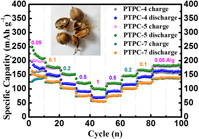Crossref Citations
This article has been cited by the following publications. This list is generated based on data provided by
Crossref.
Zhang, Yanjia
Li, Xue
Dong, Peng
Wu, Gang
Xiao, Jie
Zeng, Xiaoyuan
Zhang, Yingjie
and
Sun, Xueliang
2018.
Honeycomb-like Hard Carbon Derived from Pine Pollen as High-Performance Anode Material for Sodium-Ion Batteries.
ACS Applied Materials & Interfaces,
Vol. 10,
Issue. 49,
p.
42796.
Ren, Zongling
Wen, Jie
Liu, Wei
Jiang, Xiaoping
Dong, Yanheng
Guo, Xiaolong
Zhao, Qiannan
Ji, Guipeng
Wang, Ronghua
Hu, Ning
Qu, Baihua
and
Xu, Chaohe
2019.
Rational Design of Layered SnS2 on Ultralight Graphene Fiber Fabrics as Binder-Free Anodes for Enhanced Practical Capacity of Sodium-Ion Batteries.
Nano-Micro Letters,
Vol. 11,
Issue. 1,
Lu, Yongzhuang
Zeng, Siqi
Zhou, Lijun
Huang, Xiaolin
Zeng, Yinxiang
Zheng, Dezhou
Xu, Wei
and
Lu, Xihong
2019.
Facile Synthesis of Porous‐Carbon Nanoarchitectures as Advanced and Durable Electrodes for Supercapacitors.
Particle & Particle Systems Characterization,
Vol. 36,
Issue. 7,
Liu, Ting
and
Li, Xifei
2019.
Biomass-derived nanostructured porous carbons for sodium ion batteries: a review.
Materials Technology,
Vol. 34,
Issue. 4,
p.
232.
Rodríguez-Seoane, Paula
Díaz-Reinoso, Beatriz
Moure, Andrés
and
Domínguez, Herminia
2020.
Potential of Paulownia sp. for biorefinery.
Industrial Crops and Products,
Vol. 155,
Issue. ,
p.
112739.
Biemolt, Jasper
Jungbacker, Peter
van Teijlingen, Tess
Yan, Ning
and
Rothenberg, Gadi
2020.
Beyond Lithium-Based Batteries.
Materials,
Vol. 13,
Issue. 2,
p.
425.
Xia, Guanghui
Li, Xuebao
He, Jingjing
Wang, Ying
Gu, Yang
Liu, Luzhi
Huang, Jiemeng
Dong, Peng
Duan, Jianguo
Wang, Ding
Zhang, Yiyong
and
Zhang, Yingjie
2021.
A biomass-derived biochar-supported NiS/C anode material for lithium-ion batteries.
Ceramics International,
Vol. 47,
Issue. 15,
p.
20948.
Arnaiz, M.
Gómez-Cámer, J.L.
Gonzalo, E.
Drewett, N.E.
Ajuria, J.
Goikolea, E.
Galceran, M.
and
Rojo, T.
2021.
Exploring Na-ion technological advances: Pathways from energy to power.
Materials Today: Proceedings,
Vol. 39,
Issue. ,
p.
1118.
Liu, Heli
Liu, Huan
Di, Shuanlong
Zhai, Boyin
Li, Li
and
Wang, Shulan
2021.
Advantageous Tubular Structure of Biomass-Derived Carbon for High-Performance Sodium Storage.
ACS Applied Energy Materials,
Vol. 4,
Issue. 5,
p.
4955.
Yan, Mengdan
Qin, Yuchen
Wang, Lixia
Song, Meirong
Han, Dandan
Jin, Qiu
Zhao, Shiju
Zhao, Miaomiao
Li, Zhou
Wang, Xinyang
Meng, Lei
and
Wang, Xiaopeng
2022.
Recent Advances in Biomass-Derived Carbon Materials for Sodium-Ion Energy Storage Devices.
Nanomaterials,
Vol. 12,
Issue. 6,
p.
930.
Li, Cen
Yan, Lunjing
Wang, Meijun
Kong, Jiao
Bao, Weiren
and
Chang, Liping
2023.
Synthesis Strategies and Applications for Pitch‐Based Anode: From Industrial By‐Products to Power Sources.
The Chemical Record,
Vol. 23,
Issue. 2,
Zhu, Ziyi
Men, Yongling
Zhang, Wengjia
Yang, Wenhao
Wang, Fei
Zhang, Yanjia
Zhang, Yiyong
Zeng, Xiaoyuan
Xiao, Jie
Tang, Cheng
Li, Xue
and
Zhang, Yingjie
2024.
Versatile carbon-based materials from biomass for advanced electrochemical energy storage systems.
eScience,
p.
100249.





